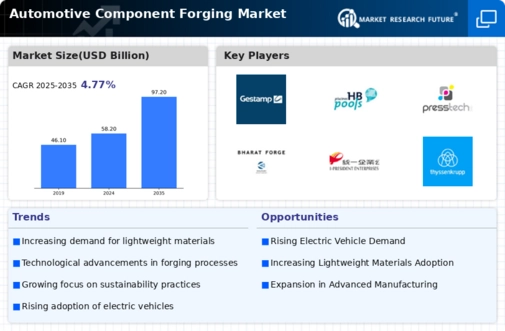Market Growth Projections
Global Supply Chain Resilience
The Global Automotive Component Forging Market Industry is currently navigating challenges related to supply chain resilience. Recent disruptions have prompted manufacturers to reassess their sourcing strategies and invest in local production capabilities. This shift aims to mitigate risks associated with global supply chain dependencies and ensure a steady supply of forged components. As companies prioritize local sourcing and production, the market may witness a transformation in operational dynamics, potentially leading to increased demand for domestically forged components. This trend could enhance the competitiveness of local manufacturers while contributing to the overall growth of the forging market.
Growing Electric Vehicle Market
The Global Automotive Component Forging Market Industry is poised for growth due to the expanding electric vehicle (EV) market. As governments worldwide promote the adoption of EVs through incentives and infrastructure development, the demand for specialized forged components tailored for electric drivetrains is increasing. These components, which require high strength-to-weight ratios and thermal resistance, are critical for optimizing performance and efficiency in electric vehicles. The market's growth is further supported by the anticipated increase in EV production, which is expected to drive the overall automotive sector. This trend positions the forging industry as a key player in the transition towards sustainable transportation.
Increased Focus on Safety Standards
The Global Automotive Component Forging Market Industry is significantly influenced by the heightened focus on safety standards in the automotive sector. Regulatory bodies worldwide are implementing stringent safety regulations, necessitating the use of high-quality forged components that meet these requirements. This trend compels manufacturers to invest in advanced forging techniques to ensure the durability and reliability of critical automotive parts. As a result, the demand for forged components is likely to rise, contributing to the market's projected CAGR of 4.77% from 2025 to 2035. Enhanced safety features not only protect consumers but also bolster manufacturers' reputations in a competitive landscape.
Rising Demand for Lightweight Vehicles
The Global Automotive Component Forging Market Industry experiences a notable surge in demand for lightweight vehicles, driven by stringent fuel efficiency regulations and consumer preferences for eco-friendly options. As automakers increasingly adopt lightweight materials, forging processes become essential for producing high-strength components that contribute to overall vehicle weight reduction. This trend aligns with the projected market value of 58.2 USD Billion in 2024, as manufacturers seek innovative forging solutions to enhance performance while adhering to environmental standards. The shift towards electric vehicles further amplifies this demand, as lightweight components are critical for maximizing battery efficiency and range.
Technological Advancements in Forging Processes
Technological advancements play a pivotal role in shaping the Global Automotive Component Forging Market Industry. Innovations such as computer numerical control (CNC) machining and automated forging techniques enhance precision and efficiency in component production. These advancements not only improve the quality of forged parts but also reduce production costs, making them more attractive to manufacturers. As the industry evolves, the integration of smart manufacturing technologies is likely to streamline operations and increase output. This technological evolution is expected to support the market's growth trajectory, contributing to an anticipated market value of 97.2 USD Billion by 2035.





















